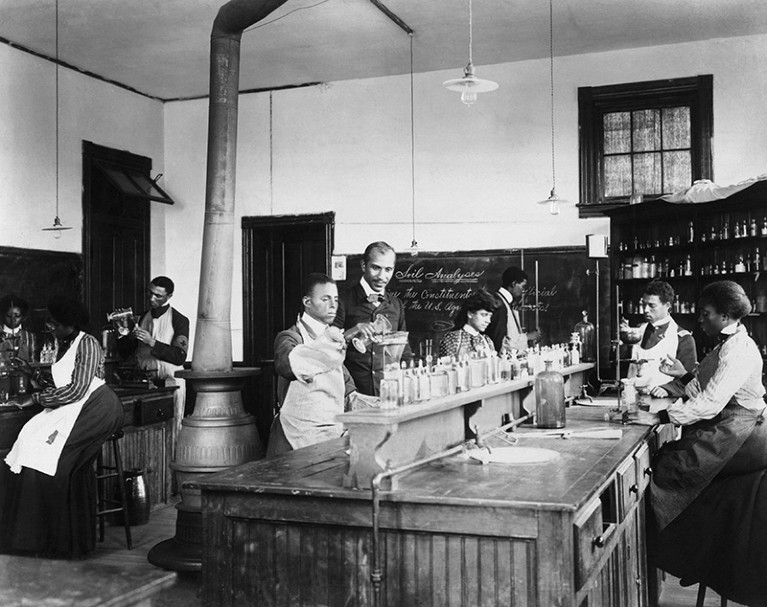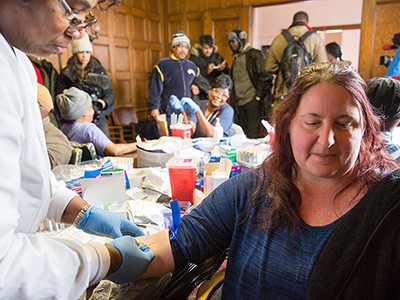
Unlike many other Black scientists from history, high-quality images of agricultural scientist George Washington Carver — shown here with students at the Tuskegee Institute in Alabama — are readily available.Credit: Bettmann/Getty
Last month, Nature published a Comment article on how researchers and communities helped each other during a water crisis in Flint, Michigan. While sourcing pictures for the article, Nature’s photo editor discovered that there are few images available of the people involved, many of whom are Black.
Recently, we also needed an image of the physicist Elmer Imes, who, in 1918, became only the second African American to be awarded a PhD in physics in the United States. His doctoral work provided early evidence of the quantum behaviour of molecules. But university archives that Nature contacted did not have a copy of his photograph. Commercial photography agencies also had nothing. Low-resolution, grainy images do exist, but, shockingly, even the US Library of Congress in Washington DC — which holds images of many important scientists from the nation’s history — does not have a photograph. However, such images are available for a number of notable white scientists from Imes’s time.
Community–academic partnerships helped Flint through its water crisis
This is far from an isolated case. Nature often illustrates articles reporting on communities and countries that are under-represented in science using generic images, in part because universities, national libraries and commercial photo agencies hold relatively few images of people from such communities.
Although we do our best to work with generic images in such situations, they tend to be less compelling than pictures showing real scientists doing real research. When we do use photographs of the researchers themselves, this can boost the impact of the article — attracting greater social media attention, for example — which, in turn, can benefit those individuals and their work.
Systemic racism and science’s diversity deficit extend to images, creating a distorted and exclusionary picture of science’s past and present. This is an issue that needs attention, and there are several potential ways to rectify it.
When it comes to photographs of living scientists from under-represented communities, it can be surprisingly difficult to obtain high-resolution images of a standard that international publishers generally require. The resolution of images on institutional websites is often insufficient. But there’s a relatively straightforward fix, at least for some institutions: where resources allow it, universities could ensure that they can provide appropriate access to high-resolution images of their researchers, if individuals have consented to this.
Katherine Johnson’s memoir charts her bold trajectory to NASA and beyond
A second and related problem — the lack of high-quality historical images, particularly of people of colour — is also not insurmountable. For example, such images might be available in university records or archives, and, if not, these institutions will often know how to find such images or will have access to ways of improving the quality of the images they do have. National libraries need to work with universities to identify and publish images of notable researchers.
Arguably the most difficult, although no less important, task will be to bring about change in the commercial photography agencies. These agencies are a crucial source of images for media organizations. At Nature, we use them all the time, and credit them next to the images. But, more often than not, our searches for photos of particular Black scientists and scientists of other marginalized ethnicities yield negative results, and we are compelled to fall back on generic images of people modelling a generic scene, instead of photos of the scientists themselves. In some cases, photos do exist, but are incorrectly captioned or are not tagged with appropriate keywords, meaning they cannot be found.
Nature approached six large agencies and asked whether they have a dedicated staff member — or an organized process — for improving diversity in their science-related images. Representatives of three agencies responded. None has such a person. One photo repository acknowledged that Black people are not represented in its images of clinical medicine, and that it is actively working to correct this. Tracking diversity needs to be a priority for these agencies.
Community action
Science publishers and media outlets — including Nature — also have a responsibility to do more to ensure we are publishing images of the people we feature. And we need to commission more photographers from the communities that we’re writing about, something Nature has particularly tried to address in our weekly article, Where I Work.
Universities, libraries, publishers and photo agencies — the organizations that hold the keys to so much of the world’s photography — must all take steps to diversify our imagery. Science’s historical record will remain incomplete while it is missing pictures of people who have contributed to discovery and invention. Such efforts are also essential to make research more welcoming for people from under-represented communities, and to ensure that future generations of researchers reflect those that science has often failed to attract in the past.

 Community–academic partnerships helped Flint through its water crisis
Community–academic partnerships helped Flint through its water crisis
 Katherine Johnson’s memoir charts her bold trajectory to NASA and beyond
Katherine Johnson’s memoir charts her bold trajectory to NASA and beyond
 The time tax put on scientists of colour
The time tax put on scientists of colour
 Racism is magnifying the deadly impact of rising city heat
Racism is magnifying the deadly impact of rising city heat
 Science diversified: Black researchers’ perspectives
Science diversified: Black researchers’ perspectives






